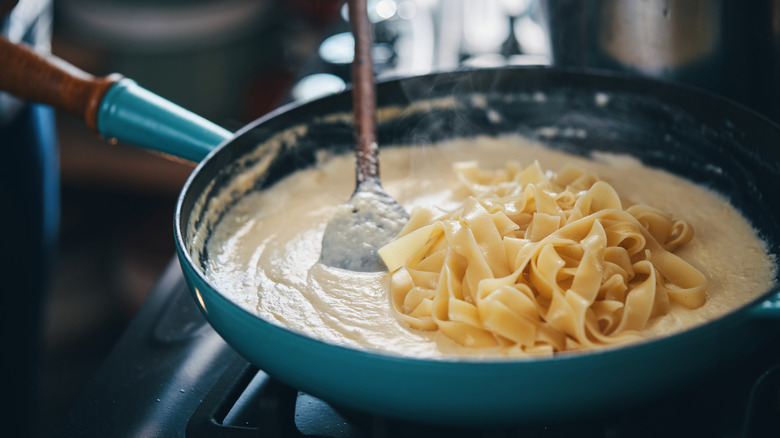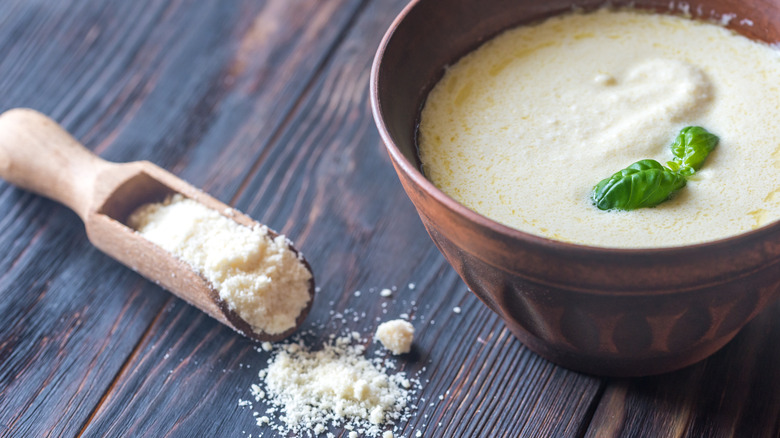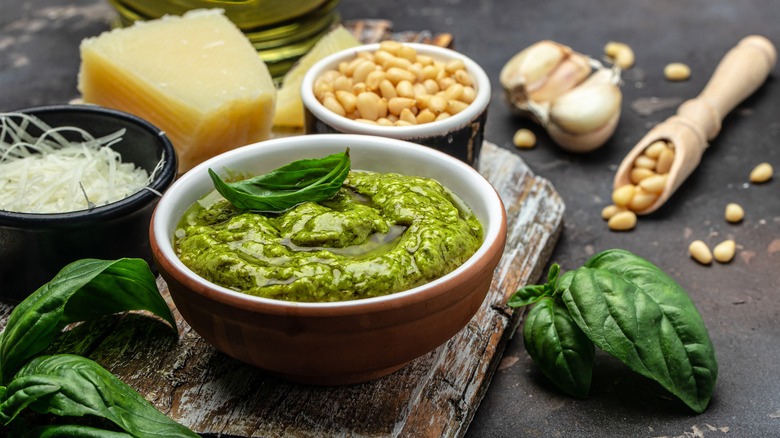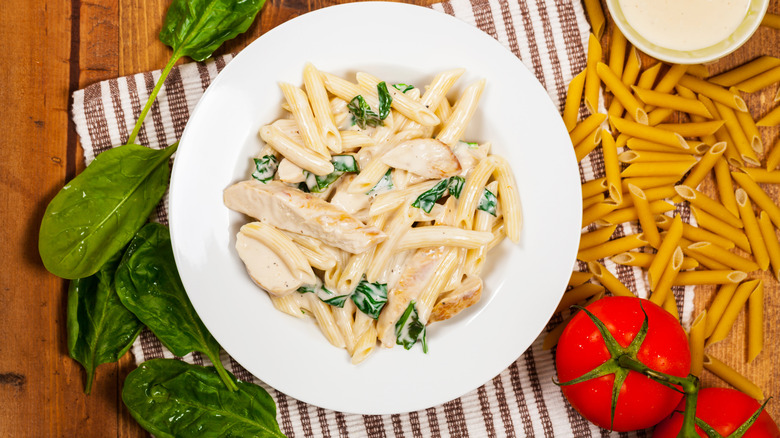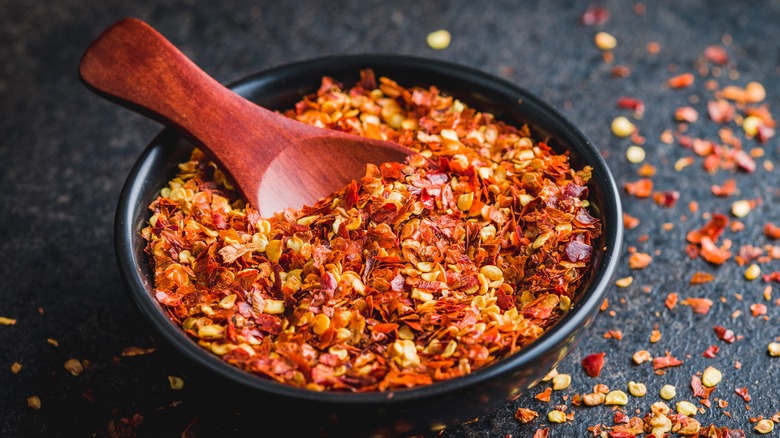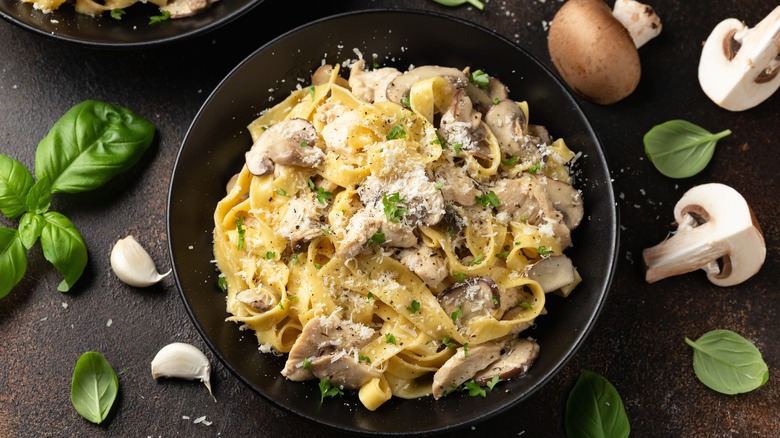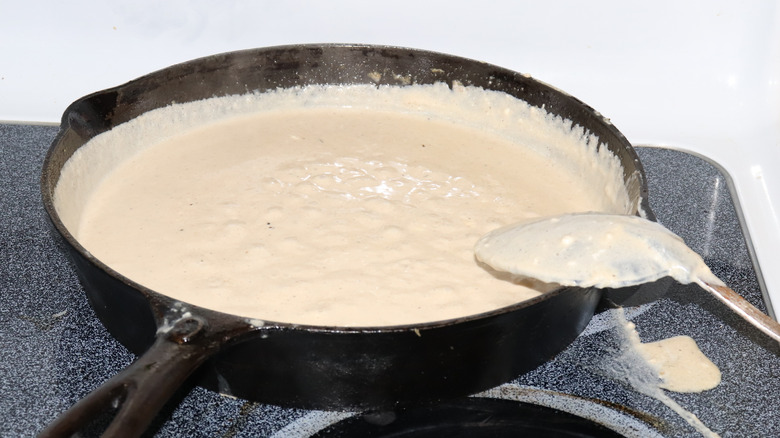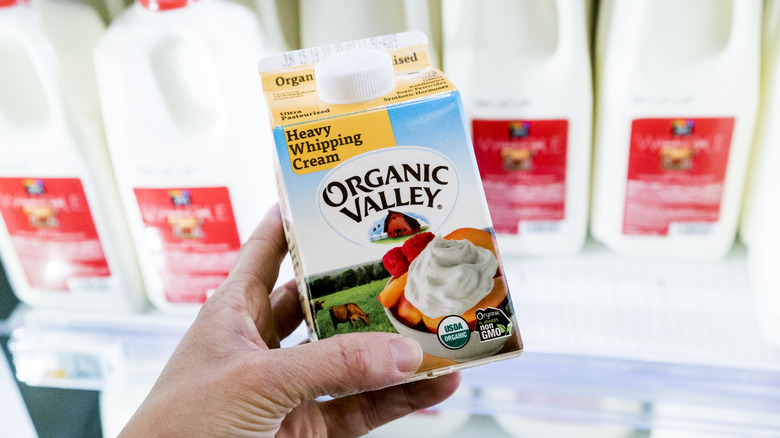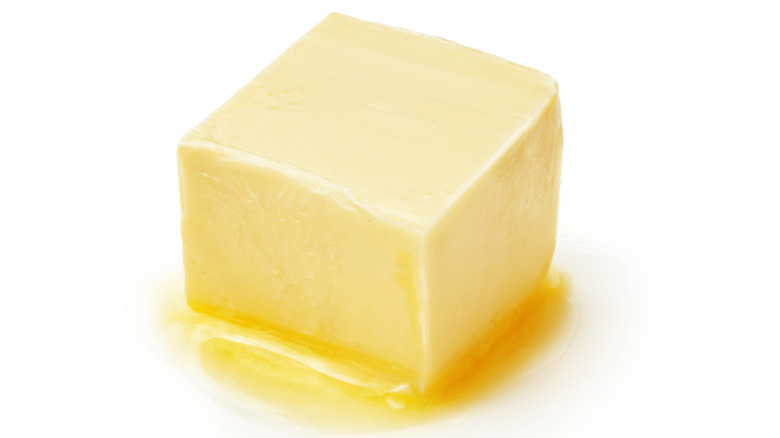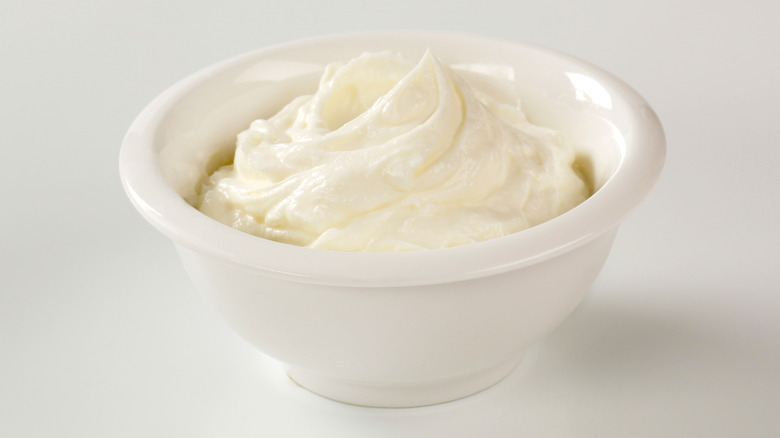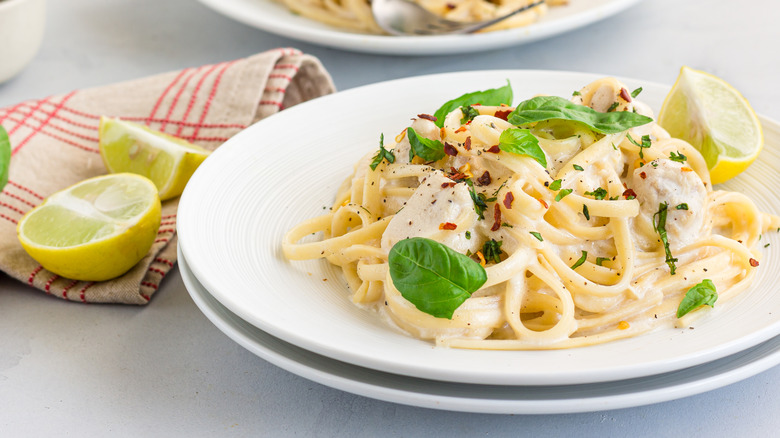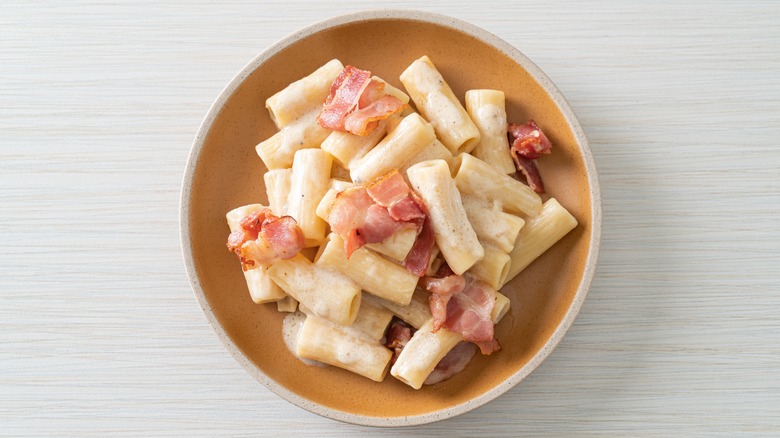15 Ways To Upgrade Store-Bought Alfredo Sauce
We may receive a commission on purchases made from links.
Alfredo sauce is fairly easy to make at home, but store-bought versions are incredibly convenient. And, with a few minor touches, they quickly become super yummy. Starting with a top-notch jarred sauce helps, too, but no matter what you have, you can seriously improve taste and texture with a few simple ingredients. From savory meats and extra cheese to veggies and bold spices, alfredo sauce is basically a blank canvas ready for you to enhance with a world of flavors and ingredients.
I love store-bought alfredo sauce. I know concocting it from scratch isn't very complicated, but I like to start with a good base and then make it my own with my favorite flavors and veggies. As a result, many of the tips in this article stem from my personal experience. I also considered popular recipes, recommendations from reputable food bloggers, and more to come up with the following 15 ways to upgrade store-bought alfredo sauce. Here's what I discovered — the next time you grab a jar of pre-made alfredo sauce, you can quickly turn it into the star of your meal.
1. Add extra cheese for creaminess and flavor
Putting some extra cheese in your store-bought alfredo sauce is a no-brainer. Most of the dishes we make with alfredo get garnished with cheese anyway, so why not just put it straight in the sauce? Not only will it add a deeper layer of salty, nutty flavor, but extra cheese also enriches creaminess and texture. If your store-bought sauce is thinner than you prefer, adding cheese helps thicken it, especially if you let it simmer for a minute so that it can sufficiently melt and blend into the other ingredients.
Plenty of different cheeses make a delicious flavor enhancer for alfredo sauce. In its most basic form, alfredo sauce consists of heavy cream, butter, and Parmesan cheese. A few spices don't hurt, either. Still, considering the primary ingredients, Parmesan is the obvious choice when searching for the perfect cheese to boost flavor without changing it much. Similar Italian cheeses like Pecorino Romano, Grana Padano, or Asiago also make great options. Closely related but not Italian, Gruyère is another tasty choice. Or, if you want to thicken your sauce and create a creamier texture, softer cheese like mozzarella and provolone may be your best bet. Finally, if you desire a considerable change in flavor, blue cheese adds a delicious bite and a funky element that won't be overlooked.
2. Stir in a touch of marinara to mimic a vodka sauce
Vodka sauce features the best elements of marinara and alfredo sauce combined. Of course, it has vodka in it, too, but tomato and cream are just as prominent. To create a fun, quick interpretation of this classic sauce, simply stir some marinara into your store-bought alfredo sauce. It blends the best flavors from both sauces and results in the creamiest red sauce you've ever had. Most tomato sauces contain lots of spices that alfredo often lacks, such as oregano, basil, onion, thyme, and more. So, when you add it to alfredo, you get an instant increase in flavor.
You can't add too much marinara to alfredo, so you'll want to gauge your proportions based on what kind of meal you are making. If you still want your sauce to primarily be alfredo, start by adding just a few tablespoons of marinara. Adversely, if you desire an extra creamy version of penne alla vodka with a bold tomato taste, adding equal amounts of both sauces is perfect.
Another reason mixing marinara and alfredo is so great is that it allows you to stretch the sauce further. I'm not sure about you, but I've always been a bit put off by the fact that store-bought alfredo jars are smaller than marinara jars. Sure, they get the job done, but I like my pasta to be extra saucy, so bulking it up with another sauce speaks to me.
3. Mix in a bit of pesto for an instant transformation
Pesto won't add a lot of volume to store-bought alfredo sauce, but its potential for enhancing flavor is undeniable. With just a few spoonfuls, you can take bland alfredo sauce from boring to delectable. Pesto seamlessly integrates into alfredo sauce and leaves a bold mark flavor-wise. Stir a couple of large tablespoons into your store-bought alfredo sauce and you'll see what we mean.
Typically, basil pesto is packed full of pine nuts, Parmesan cheese, olive oil, and of course, basil. Once blended together, they create a dense sauce ideal for a world of applications, and mixing it into alfredo is one of the best. When the two sauces combine, you get a super creamy pesto alfredo that goes great with pasta, chicken, shrimp, potatoes, and just about any vegetable, so don't hold back.
When most people think of pesto, they think of basil pesto, but it is actually more versatile than that. You can make pesto with many different ingredients that take it well beyond basil sauce, and many of them taste delicious in alfredo sauce. From artichoke pesto to lemon-pistachio pesto to sun-dried tomato pesto, the possibilities are endless.
4. Add roasted or sauteed garlic for a serious boost in flavor
While not considered an essential ingredient, garlic is a common addition to alfredo sauce. It adds a rich flavor that goes well in almost any kind of cuisine. So, why wouldn't you turn the garlic taste up a notch by adding a bit more? Even if your store-bought sauce is already a garlic alfredo, a bit more never hurts.
You can easily toss a few dashes of powdered or jarred crushed garlic into your alfredo sauce, but roasted garlic tastes even better. Roasted garlic has a distinct taste caused by the sugars caramelizing when cooked at high temperatures. It tastes a lot like other forms of garlic but with a deeper flavor and less bite, resulting in a rich additive for alfredo sauce. If you want to take it a step further, you can also make and add roasted garlic compound butter to give it a velvety element.
The amount of roasted garlic you infuse in your store-bought sauce depends on your individual taste, tolerance for garlic, and the amount of sauce you are making. I can't get enough garlic, so I typically add about six to eight large cloves of roasted garlic to my sauce. However, many people don't prefer that much, so think about who you are cooking for and what amount will satisfy your flavor preference and proceed accordingly.
5. Simmer with extra herbs and spices for added depth
One of the main reasons that store-bought alfredo sauces fall flat is for a lack of spices. Basic alfredo doesn't have much more than pepper, salt, and maybe garlic, and adding additional seasonings has the potential to turn a bland sauce around. In fact, you may be surprised by how much of a difference adding a bit of extra salt and black pepper makes. Still, there are plenty of other spices and herbs that can transform jarred alfredo sauce and make it something special.
In addition to extra black pepper, I like to add Italian spices to my alfredo sauce. I start with a dash of oregano and thyme. Then, I give it a taste to see what I think. If I still feel it needs something else, I add a sprinkle of nutmeg. It adds a deep, nutty flavor that perfectly complements the parmesan cheese in the sauce. Or, if I want something a bit different, I'll forgo the oregano and thyme and add a ton of rosemary. Fresh herbs are also great, especially when it comes to adding a reinvigorated element to alfredo sauce. Fresh basil is my favorite, and while I typically let alfredo simmer with dried herbs, I prefer to add it at the end as a garnish so that it retains its bright flavor.
6. Make it spicy with crushed red peppers and more
I love spicy foods, so I typically reach for something hot when I want to improve flavor. While it may not be the first thing others think of, alfredo sauce is no exception to the rule. After all, cheese and cream go with just about everything. My spicy ingredient of choice for store-bought alfredo is crushed red pepper. It adds a pop of color and subtle bursts of heat throughout the sauce. Plus, I always have it on hand in my spice rack. You probably do, too.
In addition to dried crushed red peppers, Calabrian peppers and hatch chilis make phenomenal choices. Calabrian peppers have a medium-hot heat, and they're from Italy, so they mix well with lots of dishes you probably make with alfredo sauce. Cayenne also makes a great alternative to Calabrian peppers if you're looking for heat specifically and not a ton of other flavors. Hatch chilis are better if you prefer a milder heat level. Some hatch chilis are pretty hot, but the kind you buy pre-chopped in a can or jar are typically pretty mild. Lastly, I tend to avoid hot sauces when I want to make my alfredo spicy because they alter the color, but they can provide you with similar results.
7. Add nutrition with sauteed veggies
We all know that veggies are good for you because they contain lots of vitamins and nutrients. We also know that alfredo sauce isn't considered super healthy due to all the cream and cheese. So, why not turn up the nutrition in your store-bought alfredo by adding some vegetables to the mix?
Luckily, most veggies integrate into alfredo sauce exceptionally well, so you should be able to find one to add to your sauce for even the pickiest of eaters. My favorite alfredo additions include green leafy vegetables like spinach, broccoli, asparagus, and Brussels sprouts. Caramelized onions and peas also make the top of my list. I like to cook my veggies in the simmering sauce. It makes preparation incredibly straightforward, and you don't have to dirty another pan. Regarding brussels and caramelized onions, I recommend cooking them before adding the sauce because they need a little extra time. You don't have to limit yourself to my favorite veggies, either — red bell peppers, tomatoes, mushrooms, and zucchini also make for a mean alfredo sauce.
8. Enrich the flavor with infused oils
Using infused oils is a fantastic way to inject bold flavors into a creamy alfredo sauce. They subtly add a wealth of yummy seasonings, and the oil lends itself well to the creaminess of the sauce. Infused oil also has the ability to thin out extra-thick store-bought alfredo sauces, but you'll have to use several tablespoons. Best of all, the sky's the limit when it comes to creative infused oil flavors. My favorite is truffle oil. It can be a bit pricey, but mixed with alfredo sauce, the rich flavor is beyond drool-worthy. Rosemary and lemon-infused oils also make excellent choices.
You can easily acquire infused oils at your grocery store; just don't expect to have a lot of options. You'll need to visit a specialty oil shop or look online for a broader range of flavors. Or, if you're already realizing how many uses there are for tasty infused oils, you may want to just go ahead and make one yourself It's pretty easy: all you need to do is warm olive oil and your ingredients of choice on the stove for about 20 minutes or in the microwave for three to four minutes, let them cool, put them in an airtight container, and enjoy.
9. Simmer for longer to make thin sauces thicker
Some store-bought alfredo sauces are a touch watery, especially the cheapest ones. As a result, they don't stick to pasta and other ingredients the way we want. Don't worry, though — there's an easy fix. Just like with other watery foods, simmering thin store-bought alfredo sauces for a bit longer than normal helps thicken them up. The excess moisture evaporates as it cooks, leaving behind all the good stuff. This is an excellent alternative if you don't plan to thicken your sauce with cheese. It doesn't require any additional ingredients, so there's no need to worry about what you have available in the fridge. All this trick needs is some heat and some extra time.
Thickening alfredo sauce on the stove is as simple as pouring it in a pan and turning on the stovetop. I like to turn the heat to medium to get it going, but once I see it start to simmer, I drop the temperature down to low. I also like to use a nonstick pan to prevent the ingredients from burning and sticking to the bottom of the pan. Even so, the cream and cheese in the pan require frequent stirring to avoid burning. Once thickened to your liking, remove the sauce from the heat and use it like normal.
10. Thin out thick sauces with extra cream or broth
On the flipe side, another common issue with store-bought alfredo sauce is that it can be too thick. If you wind up with a jar of extra thick and goopy sauce, it may not be quite enough to give you the right amount of coverage, especially when making an entire box of pasta. Sometimes, an extra thick sauce can be beneficial if you want to smother meat with it, but for the most part, it should be smooth and creamy. Many store-bought sauces thin out a bit when simmering, but cooking also leads to more moisture evaporating. Fortunately, you can just add a touch of heavy cream to create the perfect consistency for any dish you're making. Chicken or vegetable broth also works exceptionally well in these cases.
Whether you opt to infuse your thick store-bought alfredo sauce with broth or heavy cream, start slow. The last thing you want is to go too far and make it a watery mess. If you do, your sauce will still be salvageable, but you don't want to make things any harder on yourself. Begin by adding a tablespoon or two and stirring. Then, evaluate the texture and add some more if you think it is needed.
11. Mix in a few pats of butter for a simple, creamy upgrade
Butter is possibly the most incredible cooking ingredient of all. It enhances flavor in a world of cuisines and adds a rich texture and taste that people flock to. Well, guess what? It does the same thing for store-bought alfredo sauce. The scrumptious flavor of butter adds a decadent taste to alfredo sauce without altering its primary qualities. It also increases fat, which obviously tastes good. Don't believe me? I dare you to add a couple of pats of butter to your next jar of store-bought alfredo sauce and tell me I'm wrong. Seriously — sometimes all a boring alfredo needs is a little bit of butter to turn it around, and you probably have some already, so why not give it a try?
About two or three good slices of butter should be plenty in a single jar of store-bought alfredo sauce. More than that and you run the risk of making it overly oily, particularly if you wind up with leftovers and need to reheat it. So, start with a couple of pats of butter and stir them into your sauce while it heats on the stove. It will melt quickly and become part of the sauce in a matter of moments.
12. Make it unbelievably creamy by adding sour cream or cream cheese
Sour cream and cream cheese are wildly versatile in the cooking world. They combine well with an abundance of dishes, and alfredo sauce is one of them. Their creamy texture and bright, tangy taste add a bit of bite to alfredo sauce. They also help you thicken a thinner store-bought sauce. Thanks to their bulk, they allow you to stretch your sauce out, as well. Scoop a few large spoonfuls into your sauce, mix, and let it simmer for a minute or two. Then, give it a taste and marvel at the improvement.
Mascarpone cheese, which is basically the Italian version of cream cheese, is also an outstanding option when it comes to making store-bought alfredo creamier. It is a soft cheese, so it mixes in and melts fast. It is not as tangy as sour cream or cream cheese, so the sauce's flavor remains somewhat neutral. If you don't have any of these options on hand, ricotta cheese can also be used, but its high water content quickly leads to a runny sauce. I only recommend it as an option if you don't have anything else.
13. Increase the flavor with white wine
A typical white wine sauce doesn't call for much. Obviously, white wine is the star of the show, but depending on the recipe, you may only need some broth, lemon, and maybe lemon or vinegar to round it out. However, some more elaborate wine sauces also call for cream. With cream added, you're just a step or two away from having alfredo You can see where I'm going with this — Adding white wine to store-bought alfredo is a fantastic way to enrich the flavor and add a dry element that makes the other elements shine. While not necessarily considered a classic ingredient for alfredo sauce, white wine is a long-standing ingredient used in other pasta sauces, like marinara, so it's really not that much of a stretch.
I prefer dry wines all around, but dry white is a must when livening up your alfredo. If you use a sweet wine, it may not result in the desired flavor profile. Buttery wines also make a good choice, but again, they should be somewhat dry overall. Regardless, about ½ cup should be all you need to add flavor. Just make sure to let it simmer for a while so it thickens back up, and the alcohol has a chance to burn off, leaving nothing but flavor behind. Don't worry about spending a lot of money on your cooking wine, either, unless you plan on drinking the rest of the bottle with your meal.
14. Brighten the taste with white balsamic or lemon
Lemon and white balsamic are ideal for transforming a bland alfredo sauce. They both add a bright element that heavy alfredo sauces lack and a touch of acidity that elevates the flavor. You only need to add one or the other, but once you see how much it improves your store-bought alfredo, something tells me you will want to try the other next time.
As opposed to regular balsamic vinegar, white balsamic has a less potent flavor. It isn't as syrupy in texture or sweet, either. The subdued taste, thinner consistency, and, of course, lighter color all make it an excellent complement to store-bought alfredo sauce. Simply swirl some onto your simmering sauce, stir, and you're good to go.
If you opt for lemon, which may be more convenient, you can squeeze a wedge or two into your sauce or add zest from about ½ of a lemon's peel. Lemon juice will get the job done quicker, but zest is more subtle and adds bursts of brightness throughout. Lemon zest is also better if your store-bought sauce is watery because it doesn't add any additional liquid. Besides, if you let it simmer for long enough, the flavor will spread like juice does anyway.
15. Increase the protein content with meat
Alfredo sauce and meat also come together to form a splendid combination. In fact, unless you specifically order a vegetarian meal, most restaurants serve their fettuccine alfredo with some kind of meat. It's not like this pairing is anything new, and that's for good reason. Adding a bit of meat to alfredo sauce makes it juicy, tender, and, above all, delicious. All things considered, the sauce does just as much for the meat as the meat does for the sauce. So, while some chefs simply add meat to the top of a pasta bowl, stirring bite-sized pieces into the sauce can lead to positive results all around.
As you probably suspect, most types of meat make a tasty addition to alfredo sauce. Anything from chicken or shrimp to steak is a top-notch option. Pork is a favorite, particularly pancetta, prosciutto, or bacon. These options add lots of savory juices, salt, and pork flavor that permeate the rest of the sauce while cooking. Bacon also adds a delicious layer of smokiness. Aside from the typical options, feel free to play around. I once worked with a chef who liked adding a spoon of anchovy paste to their alfredo to increase saltiness, so be creative and have fun with it. Your tastebuds will thank you.

